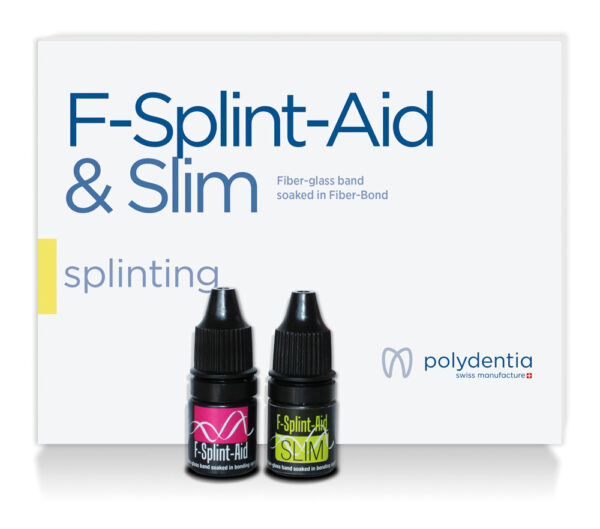26 Mai Dr. Sigrist – Periodontal Splinting – F-Splint-Aid Slim
Periodontal Splinting – F-Splint-Aid Slim
by Lukas Sigrist
Fallstudie
The female patient (77 years old) with good dental hygiene is severely troubled by the increased mobility of tooth 31. Despite missing teeth in the posterior lateral dental region, the patient wants to avoid a (partial) denture.
After consultation a generalised superficial marginal periodontitis with simultaneous occlusal trauma of tooth 31 was diagnosed.
The following case shows the splinting of tooth 31 with the other mandibular incisors.
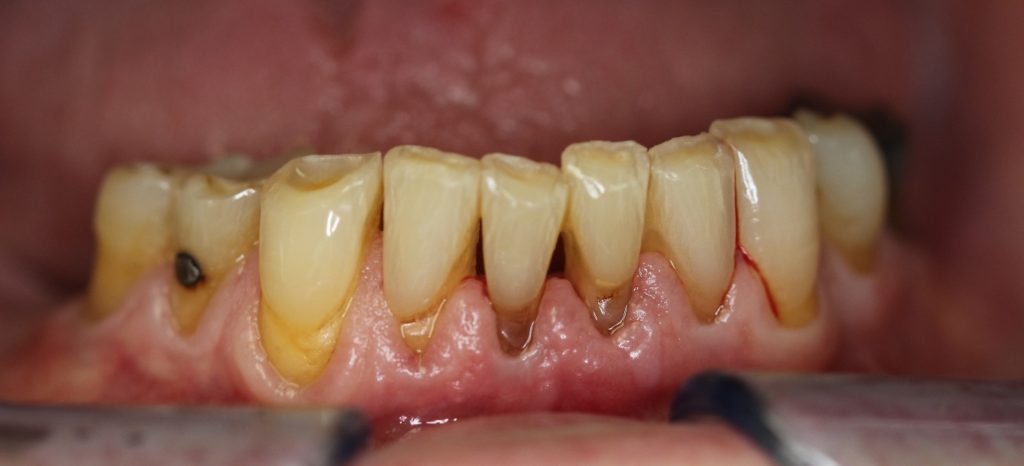
1: Pre-operative situation, buccal view of the front mandible
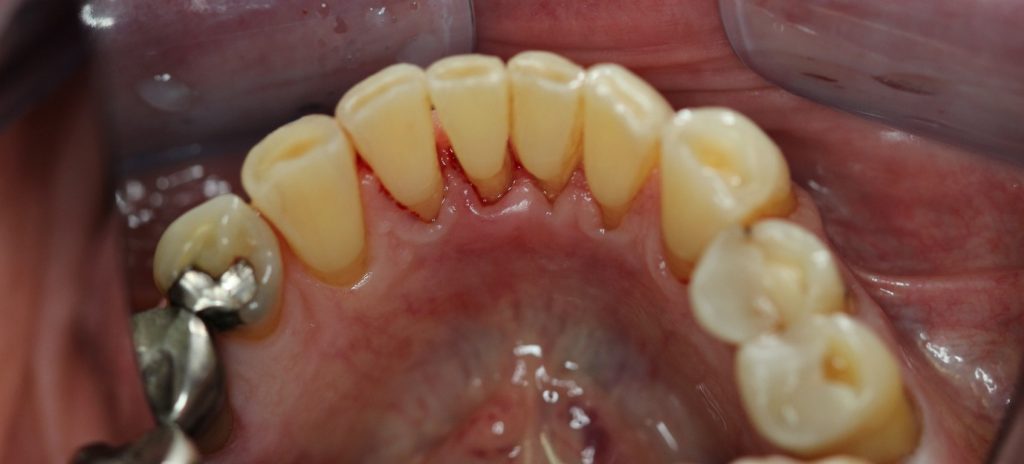
2: Pre-operative situation, lingual view of the front mandible.
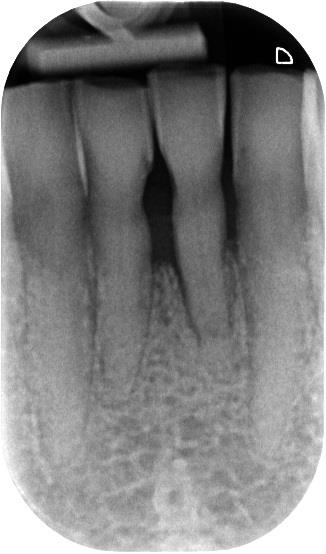
3: X-ray image of the mandible incisors.
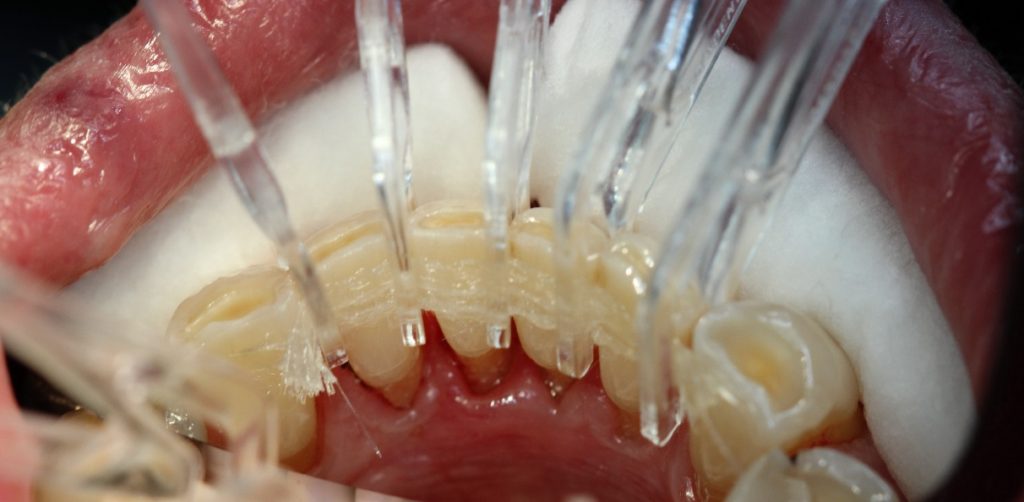
4:
After examining the occlusion, the enamel of the mandibular incisors is etched. With the heightened mobility of several teeth, initially it is recommended to lightly fix the desired position of the teeth by applying a bonding agent or a flowable composite in the interdental space.
This provides a stable working base. Then the F-Splint-Aid Slim fiberglass ribbon is neatly and precisely adjusted using the application clips. The clips facilitate an ergonomic operation, assisting in the positioning of the splint and allowing the fiberglass ribbon to be pushed well into the approximal region. In the desired position, the fiberglass ribbon can then be polymerised. After the removal of the clips, the fiberglass ribbon is covered with the flowable composite and the work is finalised.
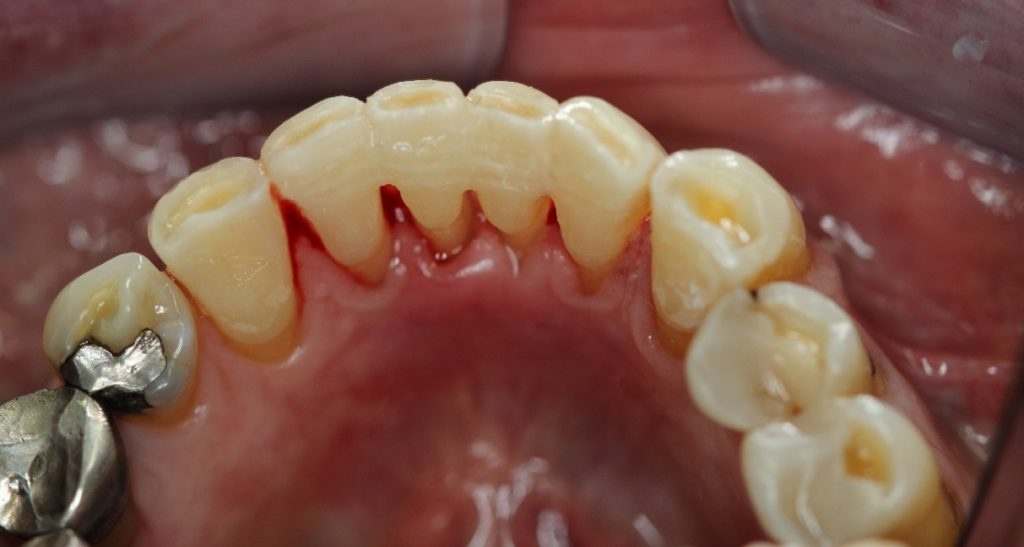
5: Post-operative lingual view of the splinting.
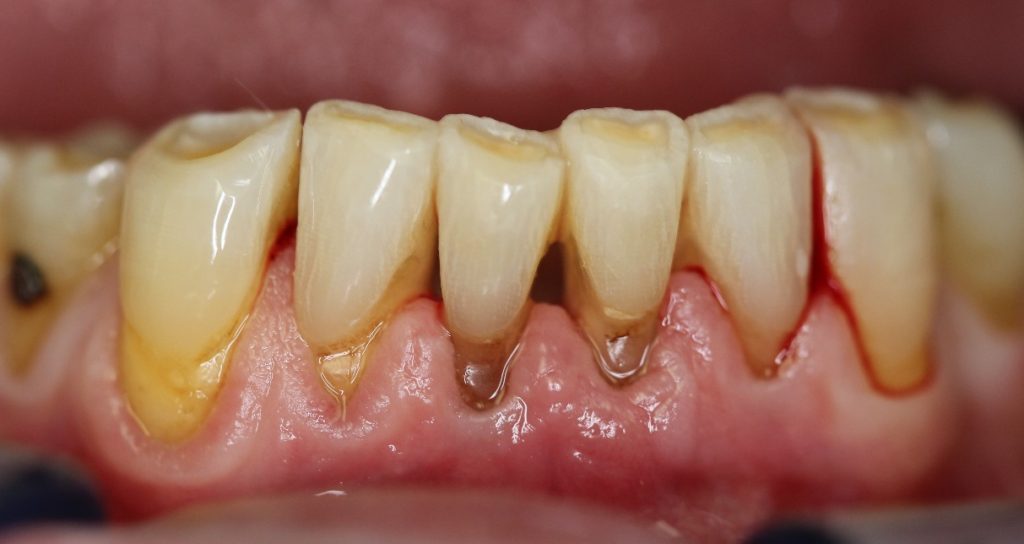
6. Post-operative buccal view after preparing the splinting. There is no aesthetic impairment and cleaning of the interdental spaces is not hindered. .
conclusions
In no time at all Polydentia’s F-Splint-Aid Slim enables the easy and inexpensive periodontal splinting of mobile teeth. As splinting with this system can be designed very delicately, it is also very well tolerated by patients. It works without disturbing the function or affecting the teeth aesthetically.
andere klinische Fälle
-
Austausch einer alten Amalgam – Füllung und Restauration einer Klasse II Kavität – myRing Forte mit myTines Large & myTines Small – Dr. Giuseppe Chiodera
Der Patient stellte sich aufgrund einer alten Amalgam - Füllung vor. Die häufigsten Probleme beim dem Entfernen von alten Metallfüllungen sind Risse, welche an der Zahnstruktur und insbesondere an der Krone auftreten können....
-
Diamond24, 24 Lösungen für Ihre Klasse II Restaurationen
Diamond24 und myRing Classico: 24 Lösungen für Ihre Klasse II Restaurationen. Lesen Sie den Artikel (in Englisch) von Dr. Chiodera, der erklärt, wie Sie gute Kontaktpunkte mit Diamond24 und myRing Classico bei Klasse II Restaurationen erhalten....
-
Direkt Restauration einer Klasse-II-Kavität an einem ersten Prämolaren – QuickmatFLEX sectional matrices e myClip Junior – Dr Marina Papachroni
Ein Jugendlicher stellte sich in unserer Praxis vor und klagte über Schmerzen im oberen linken Quadranten. Wir führten eine Klasse-II-Restauration beim ersten Prämolaren durch, ohne die Brackets zu entfernen. Auf den nachfolgenden Fotos ist das schrittweise Verfahren der direkten Kompositrestauration unter Verwendung der Teilmatrize QuickmatFLEX für den Prämolaren in Kombination mit dem pädiatrischen Teilmatrizenring myClip Junior dargestellt. ...
-
Direkte Kompositrestauration einer Klasse-II-Kavität bei einem jungen, bleibenden Prämolaren – myClip 2.0 – Dr Marina Papachroni
Bei jungen Patienten ist die Nachbildung der Anatomie bei Restaurationen von Klasse-II-Kavitäten von entscheidender Bedeutung, doch ein ebenso wichtiger Aspekt besteht darin, nicht zu viele okklusale Anpassungen nach Abschluss der Schichtverfahren vorzunehmen. Die folgenden Bilder zeigen die Schritt-für-Schritt-Behandlung, die wir zur Kariesbehandlung am ersten Oberkiefer-Prämolaren eines 15-jährigen Teenagers durchgeführt haben....
-
Direkte Restauration einer Klasse-II-Kavität bei einem jungen, bleibenden Molaren – myQuickmat Forte – Dr Marina Papachroni
(Approximal-)Karies der Klasse II betrifft die proximale Fläche von Seitenzähnen und kommt bei vielen Zahnarztpatienten häufig vor. Für den Behandler besteht eine Herausforderung darin, den physischen Kontakt zum Nachbarzahn exakt nachzubilden und gleichzeitig die richtige anatomische Approximalform wiederherzustellen. In diesem Fall geht es um einen 16-jährigen Teenager mit einer approximalen Läsion im linken Unterkiefer-Molaren (Zahn 36)....
-
Dr. Chiodera – Class III restoration with Unica anterior
The following case study shows the step-by-step restoration procedure using Polydentia Unica anterior matrix....
-
Dr. Chiodera – Klasse-II-Restauration am zweiten Bicuspidatus – myQuickmat Forte kit
Das Polydentia myQuickmat Forte Kit ist ein äußerst effektives System für Klasse-II-Restaurationen im Seitenzahnbereich....
-
Dr. Chiodera – MOD-Restauration des ersten Molaren – myQuickmat Classico kit
Das Polydentia myQuickmat Classico Kit ist ein äußerst effektives System für Klasse-II-Restaurationen im Seitenzahnbereich....
-
Dr. Fernández – Formmodifikation – Unica anterior
Ein junges Mädchen mit zwei Keramikverblendungen auf 12 und 22 kam zu uns, um ihre Ästhetik zu verbessern. Wir haben vorgeschlagen, die Verblendungen durch neue Kompositverblendungen zu ersetzen. ...
-
Dr. Gerdolle – Klasse II mesial, distal und MOD – MyClip 2.0 + LumiContrast
Nachfolgend wird die direkte Kompositrestauration zur Behandlung der Läsionen unter Verwendung von Polydentia myClip 2.0 Teilmatrizenring, LumiContrast Teilmatrizen und Holzkeilen erläutert....

